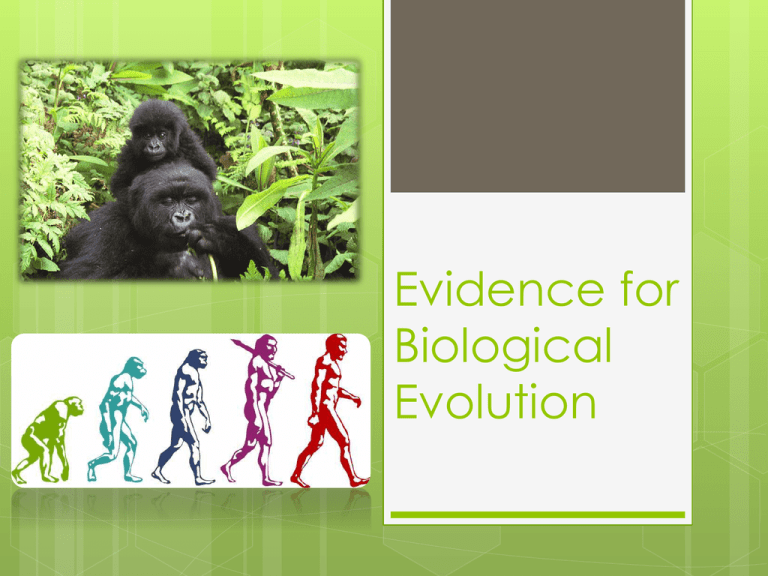Evidence for Biological Evolution
advertisement

Evidence for Biological Evolution Evolution results from 4 factors: Potential for a species to increase in number Heritable genetic variation Due to mutations and sexual reproduction Competition for limited resources Reproduction of organisms better able to survive in the environment Inherited variation & Artificial selection Individuals of each species vary. Darwin argued that variation was important. In artificial selection, humans select from the naturally occurring genetic variations in a species. Example: Dogs: all descended from wolves Selective breeding for color, hair, size, behavior Interbreeding reduces genetic variation Artificial Selection Wheat, corn, for resistance to rust, fungi, etc. USDA spends $ to breed new resistant varieties. Unintentional Antibiotic artificial selection resistance in bacteria Penicillin, Streptomycin, Tetracycline, etc. “Multidrug resistant” tuberculosis Pesticide resistance in insect pests DDT, Chlordane, etc. Remember… Adaptation = any inherited characteristic that increases an organism’s chance of survival Anatomical, physiological, behavioral Successful adaptations enable organisms to become better suited to their environment. Fitness = the ability of an individual to survive and reproduce in its specific environment. Result Survival of adaptation. of the fittest = individuals with adaptations that make them better suited to their environment survive and reproduce. Natural Selection Natural selection = the traits being selected, and increasing over time, contribute to an organism’s fitness in its environment. Results in changes in the inherited characteristics of a population, which increase a species’ fitness in its environment. Evolution by Natural Selection Darwin proposed that a type of artificial selection occurred in nature. Members of each species compete regularly to obtain food, living space, and other resources. Selection removes (some) individuals with unfavorable traits. Selection preserves (some) individuals with favorable traits. The struggle for existence was central to Darwin’s theory of evolution. Common Ancestry Homologous “same” structures, different fucntions Comparing the anatomy of fossils and living organisms All tetrapods have similar limb bones Common Ancestry examples: All primates have 5 fingers Apes and humans lack a tail Common Ancestry Embryological evidence suggests common ancestry Homologous structures develop different functions Common Ancestry The early embryonic stages of a (a) lemur, (b) pig, and (c) human show strikingly similar anatomical features. Common Ancestry: Fossil Record The only record that species changed over time Darwin’s Concept: Natural Selection Genetic variation exists within a population due to mutations and sexual recombination Competition for resources yields the survival of the fittest for a certain environmental condition Adaptations Natural are changes in genetic traits over time selection favors traits (variations) that make an organism more fit for its environment, leading to adaptations in a population over many generations. Darwin’s Finches Galapagos Islands: 14 species of finches with one common ancestor Variety of beak adaptations due to isolation of populations on different islands Ongoing competition for resources









